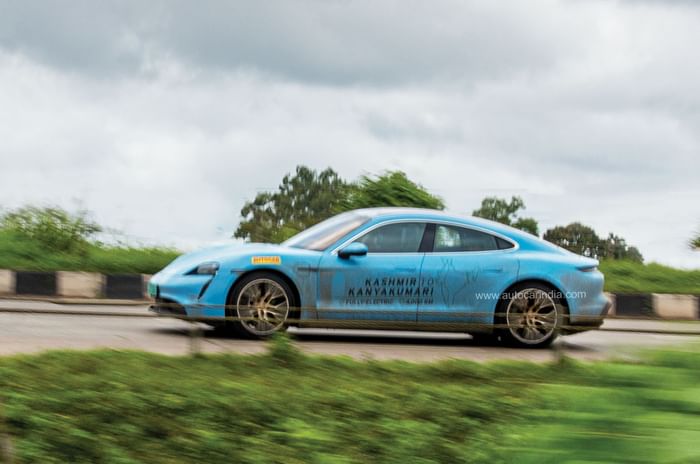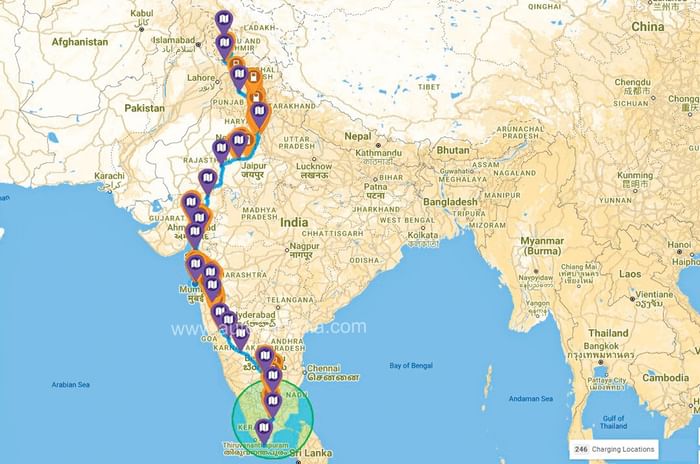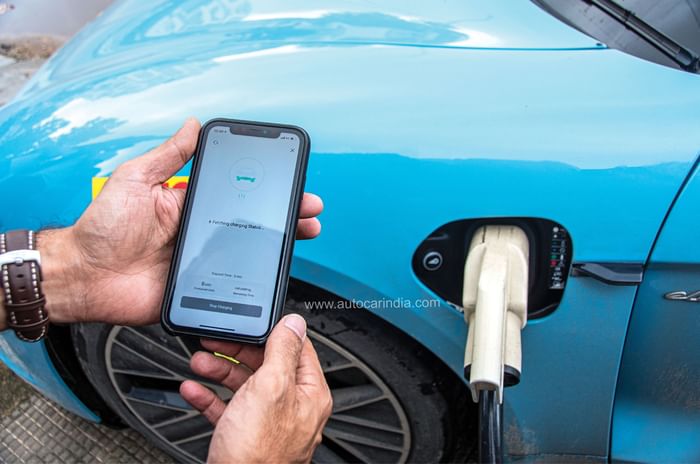There’s no doubt that, as intra-city urban transport, EVs trump ICE cars in almost every way. They’re quieter, produce no tailpipe emissions, and are vastly cheaper to run. And, if your commute is short and you have a wall-box charger at one end, it’s potentially more convenient too. Imagine never having to leave home to refuel your car!
That last advantage, however, gets flipped on its head when you attempt to go long distances between cities, as you then become reliant on the still-growing network of public chargers. With a bit of planning, though, long journeys in an EV are possible, and at Autocar India, we’ve proved that several times over.

None more so than on our epic 4,500km journey from Kashmir to Kanyakumari in a Porsche Taycan, of which I was at the helm for a big chunk. Covering distances like this does have its ups and downs, literally and figuratively, and I can tell you first-hand that while it’s possible, the experience, for now, is far from ideal.
Map your route around chargers
Of course, we couldn’t just hop into the Taycan and hit the road on a whim. While that sort of footloose spontaneity is possible in an ICE car, any long journey in an EV, and certainly one as long as ours, needs careful planning. It starts by opening a map, but not Google Maps, as you might otherwise. We used Plugshare, which is a community-driven EV charger app that actually lets you plot a route based on the location of chargers! It’s incredibly helpful, but despite this, we encountered some issues. In some of the more remote stops on our journey, such as in parts of J&K and Rajasthan, we found that some of the chargers listed on the app were not functional, not yet activated, and in one bizarre case, not even installed yet. This is why it’s important to leave your feedback on the app after you’ve used a charger (or were unable to); it’ll help others plan their journeys. In fact, look out for our comments on various chargers on the route from K to K.

When you view the full map in the app, like the image you see above, it sure looks like the charging network has covered the country like moss on a river rock. And yes, with the combined might of power companies, oil companies, vehicle manufacturers and charging start-ups, it has grown dramatically in a very short time. But zoom in a bit and you’ll see that the vast majority of them – understandably – are concentrated in and around the metro cities. What we realised quite early on in our journey is that you often have to leave the main highway to get to the charger; sometimes it’s at a dealership in town, other times at a hotel or restaurant, or maybe in a mall or public park. This too, with a little bit of planning, can be worked around. On the K2K journey, we often planned meal breaks around charging, or booked our overnight stays at hotels that had chargers attached – even if not a DC fast charger, as long as we could be plugged in all night.
Public fast charging speed far from 'fast'
This brings us neatly onto another point, because even though sometimes located just a little off route, the Indian charging network is currently robust enough that you’re never really too far away from a plug. The bigger issue at the moment is the nature of the chargers themselves. Charging takes time – it’s one of the inherent drawbacks of EV ownership, which most owners will have made their peace with, but things are improving. As tech improves, cars are becoming capable of charging faster and faster. The Taycan we were driving, for example, with its 800V architecture, can charge at up to 280kW – letting its massive 93.4kWh battery get from 0-80 percent in just 22 minutes.
Now, of course, a 280kW DC fast charger is a utopian fantasy in all but the most EV-forward European countries. But sadly in India, we’re not even close. Most of the DC fast chargers on the Indian grid have a 25kW capacity, with some going up to 50 or 60. These days some 150kW ones are cropping up, but these are few and far between, and only in the big cities. In our experience, EVs with relatively small batteries, like Nexons and ZS EVs can be topped up quick enough on these slow ‘fast’ chargers, but higher-spec electric cars with batteries in the 90-100kWh range have to stay plugged in for much longer.

So, given that speed is not on your side when it comes to charging, the next best thing you can do is make the most of the time. One of the things to do, as we mentioned earlier, is planning your charge around your lunch break, but that’s assuming there’s food nearby. “We brought in the restaurant after the charger was installed,” a fuel station owner in Punjab, whose facility was home to a new Tata Power DC fast charger and an even newer Subway outlet, told us as we waited for the Taycan to juice up. He found that while the charger was pulling in customers, they found themselves with nothing to do while they waited. Besides, it was another source of income to help offset the cost of the charger.
Expect the unexpected
Other simple things that helped us stick to our schedule on that long drive were charging to just 80 percent rather than topping up every time. To protect the battery and prevent overheating all EVs’ charging speeds slow down to a trickle at around 80 percent, so why wait out that agonisingly slow 20 percent. Besides helping us get to our next destination quicker, it’s just considerate to the next person in the queue.
And yes, there often is a queue, because as fast as the charging network is growing, it appears that electric car sales are growing faster. Queues, of course, are more likely at popular locations, and more so at ones just on the outskirts of cities, like the hugely popular Tata Motors showroom on the highway outside Pune, which has always had a car or two plugged in every time we’ve visited. This makes sense because people trust showrooms as that’s where their EV came from, and the fringes of a city are ideal charging stops for those experimenting with short road trips in their electric cars.
 We couldn't just hop into the Taycan and hit the road; every EV road trip requires careful planning.
We couldn't just hop into the Taycan and hit the road; every EV road trip requires careful planning.
Then there are quintessentially Indian challenges, like the power cut we encountered in Satara, Maharashtra. We left the car plugged in overnight, only to be awakened by an alert on the app that charging had stopped. Apart from waiting for the power to return, we had to then return to the car (which was parked some distance away) and physically restart the process. Only for it to happen again a few hours later.
Another thing to keep in mind is which brand of charger you’re going to be using on your trip, because each one has its own digital wallet for payment, and you need to be topped up. On our journey, very few took direct credit card payments and cash payments are completely out of the question, as is paying an attendant to do everything for you, as you can at a petrol pump.
Getting there
These are but small speed bumps in the otherwise quickly developing road to electric mobility in India. There are loads of positives too, like how CCS2 has quickly become the standard charging format for four-wheelers in the country, unlike in other countries where there can be two or three types. Or simply that if you get stuck in one of the random traffic jams common on Indian highways (as we did several times on our journey) you’re better off in an EV than an ICE car – because you can run the AC without having to run an engine.

The community is growing too, with apps like Plugshare creating an ecosystem of helpful tips. There’s a long way to go before fast charging stations become as common and frequent as petrol stations, but until then, if you must do a road trip in an EV, use this story as a reference, and definitely plan ahead.





































